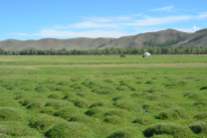I’ve traveled a lot, but I’ve never been to a country like Mongolia. Scratch that: I’ve never been to a country anything like Mongolia.
The first thing that strikes you is that this country is not really suitable for human life. The more gentle bits, such as that around capital Ulaanbaatar (“UB”), consist of treeless steppe with temperatures ranging from -40°C in the winter to 35°C in the summer. The less forgiving parts, like the Gobi Desert and Lake Uvs, dispose of unnecessary vegetation and crank the extremes up to −58°C in winter and 47°C in summer. Add in the wild temperature fluctuations caused by a continental climate at high elevation that can see UB hit temps below freezing every month of the year, and you can see why agriculture is effectively impossible.
At this point, I should note that I was born in Helsinki, Finland, ranked a respectable #5 on the list of the world’s coldest capitals (#1 is, of course, UB), and many a time I’ve wondered how on earth my ancestors survived in this arctic wasteland without central heating or microwave pizzas. But at least in Finland, we had timber for housing and heating, fish in the lakes and sea, game in the woods, crops of rye and barley, turnips and rutabagas — whereas the Mongols had, to a first approximation, none of these.
So, when the Mongols were playing Yurtcraft in Hardcore mode around 1000 C.E. and the only resources were sheep and yaks, what did they do? They built their houses out of wool, namely the felt used for yurts. In winter they ate only meat, specifically boiled mutton, and in summer they switched to a lighter diet of only dairy products. And to be clear, when I say “only meat”, I really mean only meat: no vegetables, no grain, no bread, no potatoes, nothing. Meat. For dairy, they had a choice of milk, cream, sour milk, yogurt, fresh cheese and dried cheese, but at least they could ferment some into mildly alcoholic airag (mare’s milk) or seriously alcoholic arkhi (yoghurt vodka) and so they could drink away the monotony for a while.
Given this fairly serious handicap, you’d expect the Mongolians to occupy about the same amount of space on the world stage as, say, their fellow pastoralists the Maasai of Kenya, whose colorful costumes and exotic diet regularly feature in the National Geographic but rarely beyond it. But no: the Mongols gave birth to Genghis Khan, who during his lifetime built an empire twice the size of the Romans at their height, and whose sons and grandsons proceeded to conquer China, Russia, much of the Middle East and knock on the gates of Western Europe.
Alas, the Mongol Empire lasted for only about 100 years until inevitably splitting into warring factions (maybe siring an estimated 8% of Asia’s population wasn’t such a great idea?) and it was all downhill from there for a while. The Manchu Qing dynasty eventually conquered Mongolia in 1691, and while Mongolia declared independence in 1911, Russian aid quickly turned into Soviet strings and the Mongolian People’s Republic in 1924, complete with local Stalin clone Choibalsan doing his level best to purge the intelligentsia. This created another overlay of weirdness, with Cyrillic script and hideous Soviet-style architecture still dominating the streets of UB.
In 1990, the Soviet Union and the Mongolian People’s Republic along with it collapsed, and Mongolia acquired a new state ideology: bling. This gave Ulaanbaatar its latest layer of shiny skyscrapers, modern art exhibitions, traffic jams, microbreweries, hot dog stands, fancy boutiques and even a VIP room at the train station. It must be said that Mongolia remains a poor country and most of this is far beyond the reach of the common man — but in a country where a taxi ride is $2, a tourist’s dollars go a long way.
This newfound comparative prosperity has also expanded the Mongol diet, with former festival fare like buuz steamed dumplings, khuushuur meat pies and tsuivan fried noodles now served by fast food restaurants. And when all the mutton starts to get to you — you soon realize that the entire city smells like boiled mutton — check out one of UB’s countless Korean places, serving up all the kimchi and Choco Pies you can handle.
While I found UB to be absolutely fascinating, the scenery in nearby Gorkhi-Terelj National Park was equally so and definitely worth a day trip if not more. Turtle Rock, Aryaval monastery (which sells pizza, because Mongolia), visiting a local tourist yurt, admiring the owner’s yaks and sampling many yak dairy products, pottering about on stubby Mongolian horses, visiting the yurt owner’s cousin’s distinctly non-tourist yurt and fermented mare’s milk straight out of a blue plastic bucket… not a day I’ll soon forget.
Early on the morning of our final day, we boarded train #4 to Beijing and set off on a slow trundle across the Gobi Desert. It’s large, it’s hot, it contains a whole lotta nothing — but the most striking sight was the heat-blasted, godforsaken town of Choir, a former Soviet military base that for some unfathomable reason has not been abandoned by its 8,000 inhabitants yet. The town consists entirely of commieblocks and fencing, both in severe disrepair, plus an excessively jaunty silver statue of Mongolian cosmonaut Jügderdemidiin Gürragchaa with his pants down.
At this point, I’m officially out of words. It’s about time to cross the border into China.
<<< Life on a Train | Beijing, Xi’an & Xining >>>







































